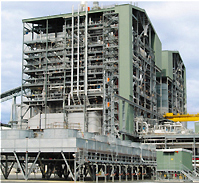coal2nuclear.com  A Plan for Our Planet
A Plan for Our Planet
►to CONTENTS
page
> 2
NUCLEAR BOILERS
Download
this page as a pdf
Back <>
to NEXT page
Chapter 2.
Supersize Part 2:
Replacing coal boilers with nuclear
boilers.
Sputnik déjà vu (all over
again): The Russian BN-800 nuclear boiler is our "Technology Opportunity"
Fast Neutron Reactor Overview - World Nuclear Association - April 2010 .pdf
BN-800 update page
http://worldwidescience.org/topicpages/b/BN-800+Reactor.html


< Replacing this.
With this. >
(Right) Rosatom
BN-800 nuclear boiler.
(Left)
230 feet high, open-air for cooling,
a pair of
Babcock & Wilcox
supersized coal
burning power plant boilers.
- Photo: B&W Brochure
Doing It. The nuclear boiler
that can replace the largest coal boilers.
Part 1
Replacing coal boilers with nuclear boilers. The "Right Stuff."
Part 2
We
can replace coal boilers with high-temperature
nuclear boilers.
Why do we have to use high temperature nuclear reactors?
Part 3
Most of the world's
slow-neutron nuclear reactors cannot replace a coal boiler.
Going with what we've got.
Part 4
The nuclear boiler that can replace the largest coal boilers.
The BN-800 - the world's best Technology Opportunity.
Sputnik déjà vu.
Part 5
Oversized nuclear boilers
make ending Global Warming financially attractive.
Part 1:
Why the author thinks the BN-800 has the "Right Stuff"
Replacing coal boilers with nuclear boilers. Its practical, beats "Clean Coal" by a mile.
(The more advanced high temperature
fast-neutron reactors are better suited for coal replacement applications than
are the older, far less uranium efficient,
and cooler slow neutron reactors. The BN-800 mentioned here is a
commercial product being sold with smaller, earlier versions going back to
1973.)
Taichung's 550 MWe GE Turbine Rosatom BN-800 880
MWe Reactor BN-800
at 2,524 psia
Conventional PWR reactor
Turbine Steam Loop
Steam Type
Superheated
Superheated
Superheated
Subcooled
Pressure (psia)
2,524
2,000 2,524
900
Temperature (°F)
1,000 (331°F
superheat)
910 (275°F
superheat)
910 (241°F superheat)
530
Sat. Temperature (°F)
669
635
669
532
Reheat Temperature
(°F)
1,000 (from 550)
No Reheat on stock unit
Reheater could be added
None
Enthalpy (Btu/lbm)
1,461
1,415
1,393 524
Internal Energy (Btu/lbm)
1,318
1,283
1,266
520
Entropy (Btu/lbm-F)
1.53
1.51
1.48 0.725
Specific Volume (ft3/lbm)
0.321
0.358
0.271
0.021
Density (lbm/ft3)
3.111
2.796
3.678
47.231 Water = 62.4
Cp (Btu/lbm-F)
0.665
0.676
0.7449 1.249
Steam compatibilities. Using the
world's largest supersized coal plant, Taichung, as the example.
Rosatom's BN-800 880MWe high temperature nuclear boiler and Taichung's GE 550
MWe turbine are a close, but not perfect fit. At 880 MWe, the reactor can
provide much more steam than the 550 MWe
turbine can use. The turbine is built for 2,524psi/1,000°F steam while the
OEM BN-800 delivers
2,000psi/910°F steam. Mass flow would be about 3,187,000 pounds of water per hour.
The BN-800 has liquid-to-liquid
steam generators as opposed to the much longer gas-to-liquid boiler tubes of a
coal burning boiler.
Can the BN-800 make the 2,524 psia steam needed
to drive the 550 MWe GE turbine to full power? Yes, but you may not want
to. Saturated steam temperature
for 2,524 psi is 669°F so making pressure isn't a problem.
Of course this does mean the superheat and reheat would be 910
°F
or 241°F
over saturated instead of the coal boiler's 331°F.
Compare the enthalpies. 95% with 910°F steam looks quite possible
without risking undue high pressure stage turbine blade/bucket erosion.
Recall that turbines cost 8% to 12% of the entire power plant so they can't be
put at risk.
Stand-alone
gas-fired superheater and reheater boosters are quite feasible. Only 90
degrees needs to come from the stand-alone boost units.
That's about 216 million BTU/hr for the superheat at 2,524 psia, 138 million
BTU/hr for the reheat at 552 psia, or a total of 354 million BTU/hr or, at $4
per million BTU, = $1,420 per hour for that last 25 MWe boost to full throttle
OEM output.
Might be worth it on peak.
Along these lines of thought:
General Electric Steam Turbine Service
advertises the services of their turbine
rebuilding division. They
suggest that they have newer blade designs for older turbines that will improve
the turbine's efficiency. After conversion from coal steam to nuclear
steam, when the turbine becomes rebuild-ready, blades optimized for the lower
superheat and reheat nuclear
steam could be installed instead of simply renewing the 20+ year old coal steam
blades.
Another aspect is what to do with all that extra steam power that
will be available on sites that have coal units smaller than 880 MWe? A
second turbine gallery with new small low-cost coal steam turbine-generators
comes to mind. The second gallery could also be located in another
unneeded portion of the coal yard. Set up the heat exchangers and
controllers to drive two separate loads?
(Below) BN-600 and BN-800 comparison.
![]()
